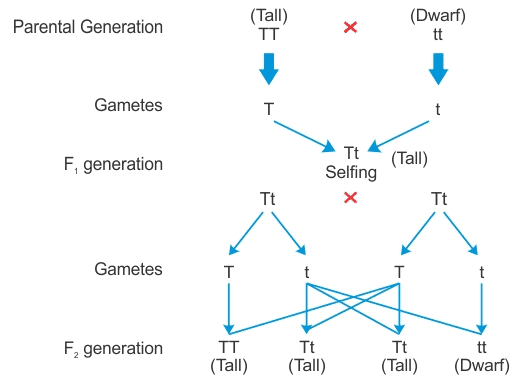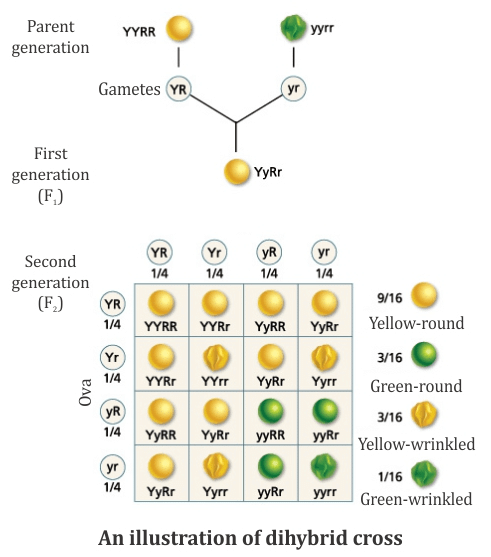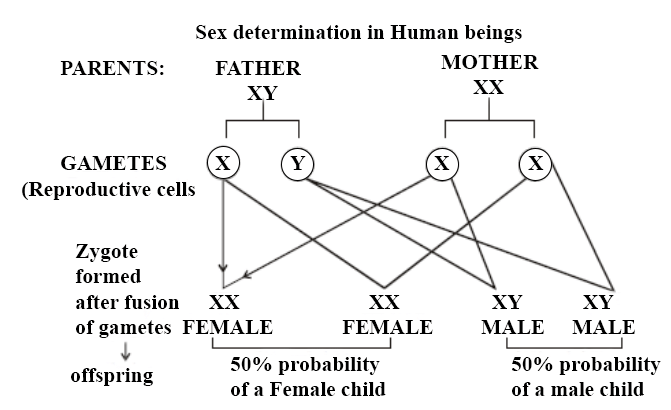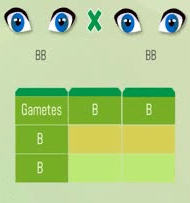NCERT Solutions for Class 10 Science Chapter 8 - Heredity and Evolution
Page No. 129
Q1: If a trait A exists in 10% of a population of an asexually reproducing species and a trait B exists in 60% of the same population, which trait is likely to have arisen earlier?
Ans.
- In asexual reproduction, the reproducing cells produce a copy of their DNA through some chemical reactions.
- However, this copying of DNA is not accurate and therefore, the newly formed DNA has some variations.

- It can be easily observed in the above figure that in asexual reproduction, very few variations are allowed.
- Therefore, if a trait is present in only 10% of the population, it is more likely that the trait has arisen recently.
- Hence, it can be concluded that trait B that exists in 60% of the same population has arisen earlier than trait A.
Q2: How does the creation of variations in a species promote survival?
Ans. Variations within a species can significantly enhance survival in changing environments.
- When environmental conditions shift dramatically, such as a sudden increase in water temperature, many organisms may struggle to survive.
- In such cases, only a few heat-resistant variants may endure, while others perish.
- If these resistant variants did not exist, the entire species could face extinction.
- While these variations aid in survival, not all variations are advantageous; some may be neutral or even detrimental.
Page No. 133
Q1: How do Mendel’s experiments show that traits may be dominant or recessive?
Ans. Mendel's experiments with pea plants demonstrated that traits can be dominant or recessive through the following steps:
- Mendel selected true breeding tall (TT) and dwarf (tt) pea plants. Then, he crossed these two plants.
- The seeds formed after fertilization were grown and these plants that were formed represent the first filial or F1 generation.
- All the F1 plants obtained were tall.
- Then, Mendel self-pollinated the F1 plants and observed that all plants obtained in the F2 generation were not tall.
- Instead, one-fourth of the F2 plants were short.

- From this experiment, Mendel concluded that the F1 tall plants were not true-breeding.
- They were carrying traits of both short height and tall height. They appeared tall only because the tall trait is dominant over the dwarf trait.
Q2: How do Mendel’s experiments show that traits are inherited independently?
Ans. Mendel's experiments demonstrated that traits are inherited independently through careful cross-breeding of pea plants.
- Mendel crossed pea plants having round green seeds (RRyy) with pea plants having wrinkled yellow seeds (rrYY).
- Since the F1 plants are formed after crossing pea plants having green round seeds and pea plants having yellow wrinkled seeds, F1 generation will have both these characters in them.
- However, as we know that yellow seed colour and round seeds are dominant characters, therefore, the F1 plants will have yellow round seeds.
- The first generation (F1) plants displayed the dominant traits, resulting in yellow round seeds.
- When F1 plants self-pollinated, the second generation (F2) exhibited a variety of combinations:
- Yellow round seeds (9/16)
- Green round seeds (3/16)
- Yellow wrinkled seeds (3/16)
- Green wrinkled seeds (1/16)
- The ratio of these traits in F2 was found to be 9:3:3:1.
- This indicates that the traits for seed shape and colour are inherited independently.

Q3: A man with blood group A marries a woman with blood group O and their daughter has blood group O. Is this information enough to tell you which of the traits − blood group A or O − is dominant? Why or why not?
Ans. No, this information is not enough to determine which trait is dominant between blood group A and O. Here’s why:
- The blood group of the man with group A can be either AA or AO.
- Since their daughter has blood group O, she must have inherited an O allele from both parents.
- This means the father must have the A allele as AO to pass on the O allele.
- However, without knowing the blood groups of all offspring, we cannot definitively conclude which trait is dominant.
Q4: How is the sex of the child determined in human beings?
Ans. In human beings, the sex of a child is determined by the combination of sex chromosomes inherited from the parents:
- Females have two X chromosomes (XX).
- Males have one X and one Y chromosome (XY).
During reproduction, each parent contributes one sex chromosome:
- The mother can only provide an X chromosome.
- The father can provide either an X or a Y chromosome.
Thus, the sex of the child is determined as follows:
- If the child inherits an X chromosome from the father, the child will be a girl (XX).
- If the child inherits a Y chromosome from the father, the child will be a boy (XY).

- Thus, the mother provides only X chromosomes. The sex of the baby is determined by the type of male gamete (X or Y) that fuses with the X chromosome of the female.
Exercises
Q1: A Mendelian experiment consisted of breeding tall pea plants bearing violet flowers with short pea plants bearing white flowers. The progeny all bore violet flowers, but almost half of them were short. This suggests that the genetic make-up of the tall parent can be depicted as
(a) TTWW
(b) TTww
(c) TtWW
(d) TtWw
Ans. (c)
Explanation:
- The genetic make-up of the tall parent can be depicted as TtWW
- Since all the progeny bore violet flowers, it means that the tall plant having violet flowers has WW genotype for violet flower colour.
- Since the progeny is both tall and short, the parent plant was not a pure tall plant.
- Its genotype must be Tt.
- Therefore, the cross involved in the given question is
- Therefore, half the progeny is tall, but all of them have violet flowers.
Ans: No. From the given statement, we cannot say with certainty whether light eye colour is dominant or recessive. However, since both children and their parents have light eye colour, the possibility is that light eye colour is a recessive trait. Had the light eye colour been a dominant trait, the homozygous light eyed parents would have only light eyed children but heterozygous light eyed parent might had some recessive dark eyed children (3 : 1 ratio).

Q3: Outline a project which aims to find the dominant coat colour in dogs?
Ans: To determine the dominant coat colour in dogs, follow these steps:
- Select a homozygous black male dog (BB) and a homozygous white female dog (bb).
- Crossbreed the two dogs to produce the F1 generation.
- If all offspring are black, it indicates that the black coat colour is dominant over white.
Q4: How is the equal genetic contribution of male and female parents ensured in the progeny?
Ans: The equal genetic contribution of male and female parents to their offspring is ensured through the following mechanisms:
- Each parent produces gametes that contain half the genetic information needed for the offspring.
- The father contributes 23 chromosomes and the mother contributes another 23 chromosomes.
- This results in a total of 46 chromosomes in the offspring, ensuring equal genetic contribution from both parents.
|
80 videos|569 docs|80 tests
|
FAQs on NCERT Solutions for Class 10 Science Chapter 8 - Heredity and Evolution
| 1. What is heredity and why is it important in genetics? |  |
| 2. What are the basic principles of Mendelian inheritance? |  |
| 3. How do dominant and recessive traits differ? |  |
| 4. What role do mutations play in heredity? |  |
| 5. How can understanding heredity help in agriculture and medicine? |  |

















